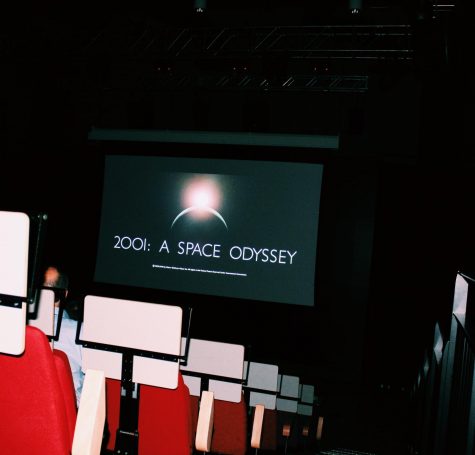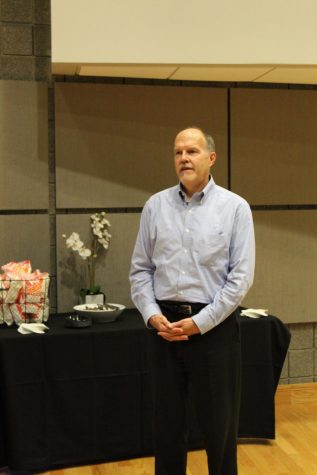50th anniversary film fest takes students back to 1968
"Bullitt," “Night of the Living Dead,” “Rosemary’s Baby” and more screening in the Digitorium
September 14, 2018
A dark room, the bright lights gleaming down on students, the sound of an oldie but goodie, film bursting through the speakers. The theater experience. It’s treated like something from a bygone era. Forget the phone screens and forget Netflix. Just a big screen, a buttery bag of fresh popcorn and a 50-year-old iconic film staring students in the face.
NKU’s Gold Anniversary on the Silver Screen: A Look Back at 1968 Film celebrates 50 years of NKU through the language of cinema. The festival takes students back in time to an America that was at the height of the Vietnam War, Martin Luther King, Jr. and Robert F. Kennedy were tragically assassinated and a small college in Northern Kentucky had its start.
The festival was an idea pitched by Dr. John Alberti, chair of the Department of English, to Dr. Andrea Gazzaniga, director of Cinema Studies at NKU. Alberti said it was just a fleeting idea, but Gazzaniga took it and turned it into something real. She reached out to faculty members across the Electronic Media and Broadcasting, Communications and World Languages and Literature departments who wanted to share their love of cinema with students.
Faculty members Chris Strobel, John Gibson, Lex Pulos, Tracy Songer, Sara Drabik and Allen Ellis joined the festival, acting as the committee that decided on the featured films.
The idea was to include films with significant impact that students would have watched in 1968 along with lesser known films that are still important to film history.
“Can you talk about film history without talking about this film? No you can’t,” Gazzaniga said. “You can’t not include ‘2001: A Space Odyssey.’”

Students watch a screening of “2001: A Space Odyssey” in Griffin Hall’s Digitorium on Sept. 13, 2018.
The small committee decided on the films: “2001,” “Planet of the Apes,” “Bullitt,” “Night of the Living Dead,” “Rosemary’s Baby,” “The Producers,” “Faces” and “Monterey Pop.”
Gazzaniga said she wanted to show that NKU’s film culture wasn’t isolated to a few professors and could instead reach a much broader spectrum for students and professors across campus.
The festival isn’t just a chance to celebrate NKU’s 50th anniversary, but a chance to re-create something both Alberti and Gazzaniga feel are missing now, the theater experience.
Alberti said there’s always this truism about movies going back since the beginning of cinema; that movies are on their last legs. People have “prematurely” been calling the death of the cinema for a long time.
This belief is becoming more prominent with online services like YouTube and Netflix. Why go to a theater and pay for an over-priced ticket when a TV or phone can offer the same for less?
In the past, before even VHS, the only way to watch a film would be to see it in theaters.
Gazzaniga said the festival is an opportunity to experience these films like it was 1968 all over again.
“Because of our lives being dominated by screens, we now have this ability to watch movies anywhere…,” Gazzaniga said. “What that doesn’t give you is a communal experience of the movie. When people watch movies together, or watch separately, there’s always this desire to talk about it.”
Alberti said a number of students who attended the “Planet of the Apes” screening had already seen the film, but were excited to see it again on the big screen.
Gazzaniga said classic films are similar to book clubs. People get together to watch a classic film. Afterwards, they discuss what they liked, disliked, its influence, the historical significance, etc. There’s someone to enrich and guide discussion based on their expertise.
At each screening, a professor acts as faculty presenter, with discussion questions and points setting the stage for students to talk about. It might be on the historical significance of a film, or how a director used camera angles or lighting to set the mood of a scene.
“It allows us to have that discussion afterwards I think most people are starved to talk about,” she said. “It feeds that desire to talk about something you just watched.”
Alberti said the framework of 1968 reflected fear and anxiety as caused by events of the day. There was fear, but hope and optimism complemented it. Civil rights movements were rising, and even something like Star Trek’s first ever televised interracial kiss had lasting effects on the public.
Some of the films chosen represent that hope and fear present 50 years ago.

Dr. John Alberti, chair of the Department of English, says the selected films reflect the anxiety and hope of the times.
For example, “Planet of the Apes,” the Charlton Heston-led science fiction classic, argued for science and evolution in a time when it was unheard of to talk about. Alberti said these themes seem strangely relevant today. A film like that could experiment with subject matter, violence and nudity.
Rebecca McKenney, a senior library informatics major, attended the “Planet of the Apes” screening, hosted by Strobel and Alberti. She said the screening helped her to view the film in a different way than she’d seen before.
“The first time I saw ‘Planet of the Apes,’ it was no bigger than on a laptop,” McKenney said. “On the big screen, there’s a larger scale and it’s easier to pay attention to details you might miss.”
She said she when she first watched it, she knew nothing about 1968. Now, when she watched it, she understood the metaphors about the Cold War.
“There’s a moment in the film where Charlton Heston realized we nuked the planet and that’s how the Apes took over,” McKenney said.
Alberti called “2001” “the space movie.” Every sci-fi movie since has had shots similar to the ones in “2001.” There’s a shot in the film called “the astronaut shot” where the sun will reflect off the astronaut’s helmet. To pay homage, every film with an astronaut has used a similar shot since then.
“2001” was iconic for its beautiful, yet confusing visual storytelling. Alberti said it’d be hard to pitch that film to a studio just because you can’t explain what’s going on in it. The third act has no dialogue, depending only on the trippy visuals and the viewer’s interpretation to tell its story.
Some of the films they chose were “daring” for the time period. For example, “Faces,” directed by John Cassavetes, was experimental because it was one of the first films not involved with the Hollywood system, Gazzaniga said. She called it “an indie film of its time.”
“It was an early independent film that took some risks with filmmaking that are the kinds of things we see in films today,” Gazzaniga said. “There wasn’t any kind of large studio apparatus. It wasn’t a film created for the box office.”
Gazzaniga believes students can learn that it doesn’t take a big budget to create a good film. She said it would be good for students to see a vision, someone’s will to execute it and produce it through hard work.
“Bullitt,” the Steve McQueen-led police drama, innovated the car chase scene that every action movie uses now. The film also created the car-jumping-over-a-hill action cliché as seen in shows or movies like the “Dukes of Hazard” or the “Fast and Furious” movies. Gazzaniga said it’ll be interesting for the students to watch a police drama that predates modern technology like cell phones and computers.
“Imagine all the crime dramas you see now, how pivotal it is to have cell phones and computers,” Gazzaniga said. “Students will think ‘How the heck did these people pursue criminals?’”
With all the influence these films had on cinema, they are more contemporary than films you’d see before 1968.
“One argument I make is this is the start of the contemporary period,” Alberti said. “…When you watch movies from the early ‘60s or ‘50s, they seem like historical movies.”
Because of the film style and their influence, students can watch any one of these films and not feel like they’re watching something dated.
The festival continues with “Bullitt” at 6:30 p.m. on Sept. 27. “Night of the Living Dead” plays Oct. 18. “Rosemary’s Baby” plays Oct. 25. “The Producers” plays Nov. 15. “Faces” plays Nov. 29. The festival ends with “Monterey Pop” on Dec. 6.
